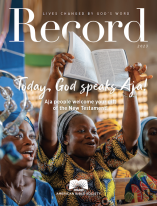How to Move Bible Readers from Passive to Active Participation
The stages of participation
Participation takes many forms. Understanding the different stages can help as you mobilize others toward a more robust understanding of Scripture. The following types of participation are adapted for Scripture engagement from an economic model, Jules Pretty’s Typology of Participation.
When I was doing research on types of participation for my book, I came across this typology which was originally intended as an economic development tool. I am continually amazed at how applicable it is for ministry. Each stage of this model can be seen as a stepping stone marking your people’s progress from passive to active, or self-mobilized, participation. But the order of this list may not always determine the path one takes. Take time to determine where you are as a leader and how to move your faith community toward a more fully engaged spiritual life immersed in Scripture.
1. “Passive Participation”
This stage can be likened to a parental relationship with young children. The parent makes decisions and tells the child what to do. The child participates as instructed.
Most of us would never have gotten into Scripture if a spiritual “parent” had not first told us how to participate. It’s how we are most often introduced to the Bible. In corporate church services, this is the type of participation that happens between a pastor and a congregation.
This first step of participation is foundational. Many mature Christians will passively participate in Scripture their whole lives, through Sunday worship or ongoing mentoring. However, when leaders parent well, they allow their flock not only to engage in passive participation, but to also formulate questions and think through what the spiritual “parent” teaches. They do this by asking questions that provoke critical thought, self-reflection, and communal change. These leaders aren’t afraid of their words being questioned because they know that questioning is a crucial part of maturing.
2. “Participation by Consultation”
This stage can be likened to a teacher in an elementary school classroom. The teacher has her lesson plan, and while she allows for questions, she directs the conversation to stay on the topic she has chosen.
This form of participation can be seen in a small-group setting in which the leader lays out a clear path for Scripture engagement. The leader dictates what the Scripture passage will be and carefully directs all discussion about the passage. The small group leader redirects when a participant gets too far away from the biblical text or imparts incorrect theology to the group. Discussion is allowed, but it is monitored and corrected if necessary.
As the small group matures, the teacher opens up the discussion more and more and becomes less monitoring. The leader increasingly moves the small group toward engaging Scripture in a way that isn’t solely reliant on them, empowering people to engage in the conversation on their own.
3. “Participation for Material Incentives”
In this type of engagement, participants are motivated to act in return for some additional reward.
Sometimes people need an incentive, something tangible, to get them started on a path that leads to larger but more intangible rewards. In Vacation Bible School settings, for example, rewards are used to get children to engage with Scripture—candy, stickers, or prizes as the initial incentive to memorize a Scripture verse. In other settings, participants may receive monetary compensation, increased status in the community, or recognition and approval from church leaders in exchange for their participation.
Leadership, in this stage, is still very much in control of how volunteers engage with Scripture. But as the community matures, the leader must move people beyond incentives, as they can be a distraction from true engagement. Material incentives may bring people into the community, but this type of engagement is not sustainable. Eventually, participants need to reach a point of self-motivation, of wanting to spend time in the Bible because they recognize its benefits themselves.
4. “Functional Participation”
In this stage, participants help leaders achieve leadership goals. Within the context of smaller groups, participants share in decision-making that contributes to the outcome of bigger projects.
Imagine a small group setting in which the church leadership team has a certain passage of Scripture in mind to present to the congregation, perhaps from the coming week’s sermon. In a closed meeting, they ask volunteers to help flesh out how to integrate the Scripture into worship. The leaders identify the passage and ask for insight into what concepts the volunteers connect with most.
This process will also help leaders identify participants who are capable of leading discussions on their own. A good leader will be looking to see how to help volunteers continue participating in making larger decisions.
5. “Interactive Participation”
This is the first clear step toward participating independently of the leader. They realize they are a valuable part of the process, in their own right.
Interactive participation in Scripture engagement develops as congregation members become partners in what the church is trying to achieve. For these more mature leaders, participation is seen as normal, expected, and part of what makes the ministry alive and thriving. This could be in their small group settings or corporate church life. This is an indication of a healthy church; people are involved and taking ownership of their role in the community.
6. “Self-mobilization”
This stage is full, autonomous participation. Participants begin making their own decisions. While accountability is always essential, these participants can take responsibility for their own actions without needing such close instruction or monitoring.
When participants become self-mobilized for Scripture engagement, they begin to feel more confident to seek out resources on their own. Just like a teenager becomes an adult, they will always be a child of their spiritual community, but they may also begin to initiate engaging on their own or with others. Scripture engagement is not something they are told to do, but rather something they love to do and initiate doing.
Effective leaders set others on the path towards self-mobilization. As we disciple and equip people to engage Scripture—as together each of us are changed by the living and powerful Word of God—they will be better able to go and do the same.

Gena Thomas
Gena Thomas is a lifelong writer and faith wrestler. She was a missionary in northern Mexico alongside her husband, Andrew, for more than four years where they started a coffee shop ministry, El Buho. Gena holds a master's in International Development from Eastern University. Gena and Andrew live in North Carolina with their two children, Cademon and Juniper. Her book, A Smoldering Wick: Igniting Missions Work with Sustainable Practices can be found on Amazon. She’d love to connect with you on social media @genaLthomas.
Thanks to the support of our faithful financial partners, American Bible Society has been engaging people with the life-changing message of God’s Word for more than 200 years.
Help us share God's Word where needed most.
Connect with our Bible engagement blog for leaders and receive a Bible-reading Habit Guide for your community.









